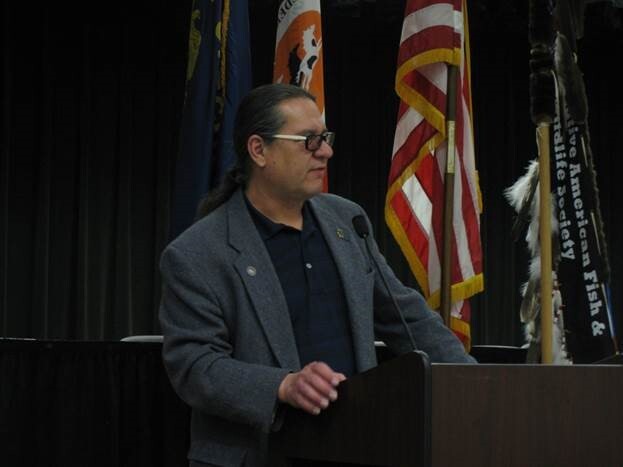Here at the Center, we wish to express our gratitude for the many contributions Indigenous people have made to sustaining biodiversity, reversing habitat fragmentation, and resisting environmental injustice.
In celebration of Native American Heritage Month, each Monday in November we will be sharing stories from four Indigenous conservation practitioners.
These conversations offer an opportunity to hear from Indigenous conservationists about their experiences, their path to working in conservation, and their visions for a future that honors Indigenous peoples and achieves collective conservation goals.
We hope you enjoy these stories.
In our third installment of our Native American Heritage Month Partner Spotlight series, we sat down with Mike Durglo. Mike is a member of the Confederated Salish and Kootenai Tribes (CSKT) and currently works as the department head of the CSKT Preservation Department and chairs CSKT’s Climate Change Advisory Committee.
Introducing Mike Durglo
Mike has worked for the tribe for 38 years, mostly in the natural resources department. Mike started his career in public service in 1979, when he enrolled in the Tribal Police Academy in Brigham City, Utah, just two weeks after graduating high school. Mike was a police officer for about a year when he decided he would pursue other avenues to serve people and nature. He became a game warden and worked in that role for 13 years.
In the mid 1990s, he decided to pursue public service, running for and winning a seat on CSKT’s Tribal Council. He served from 1996-1999, when he decided not to run for another term and instead to enroll in college, exactly 20 years after graduating high school.
Back in school, Mike was a full-time student and worked half time at the tribal water department to provide for his wife and children. He graduated in 2002 with a bachelor’s degree in environmental science from Salish-Kootenai College.
He then went on to work full time at the natural resources department as a water quality technician. He worked his way up from there, working in wetlands management before moving onto a role as a water quality regulatory specialist, later being promoted to manager for the environmental protection division. His managerial position was his first step into climate change related work. In 2012, he was offered the opportunity to coordinate a climate change plan for the tribe.
“Cultural Resources are Natural Resources”
Fast forward to today and Mike is presenting his work on climate change at conferences alongside Winona LaDuke, Dan Wildcat, and others. Mike has been able to share his knowledge with other tribes and at universities across the country. Mike was set to travel to Mongolia to share his work with tribes and villages in the area when Covid-19 hit this year.
When asked recently by a colleague, “Mike, why are you still doing climate change?” Mike replied, “Why are you not? It impacts all of us, in every way. Cultural resources are natural resources, they’re the same thing.”
When asked to consider his vision for the work he does and the legacy he intends to leave, Mike quickly responded, “Just making a difference.” He expanded in sharing that he views his climate change plan as a living document and emphasizes the need for its use to be a continuous process that takes engagement from all stakeholders.
Environmental Advocates for Global and Local Ecological Sustainability (EAGLES)
He sees great value in engaging the youth in his community in this climate change adaptation process. Mike created the Environmental Advocates for Global and Local Ecological Sustainability (EAGLES) program to create interest in climate change and natural resource related management. EAGLES created a recycling program for each school on the Flathead Reservation, which was met with great enthusiasm. The program has grown from about 40 participants to over 400 in the years since its creation.
People that do important things in his community sometimes will have a street, a building, a room in a building named after them. Mike says that’s of no interest to him:
“That’s not the legacy I want to leave. The legacy I want to leave is to make this EAGLES program international. My dream is to have a regional EAGLES summit, a national EAGLES summit, and an international EAGLES summit. Some of our kids have been connecting with students in New Zealand.”
Mike Durglo

Mike happily shared that the recycling program ended up being a bit competitive. He sees this competitive spirit as a means to drive youth engagement in an important issue that can result in a lifetime of work. Mike closes by reiterating, “You know I don’t want my grandkids saying that street there, that house there, that room there is named after my papa. I want them being there saying you know why we’re doing this? Because my papa started this.“
Working Together
In our closing question, we asked Mike what advice he has for both tribal and non-tribal stakeholders who hope to collaborate with CSKT on climate related issues:
“We need you at the table, we need you here.” He continues: “The way I see it, we’re pushing this cart up the mountain, but not everyone is pushing the cart. Some people are actually in the cart riding it up. Some people are even putting sticks in the spokes, stopping us from reaching a goal that benefits all of us.” He goes on to expand on the need for collaboration across various levels of community and government. “Climb on the boat. Climb on the boat and grab an oar.”
Further Learning
Mike calls for folks to use Native American Heritage Month as an opportunity to listen and to and learn about indigenous history as it relates to our shared heritage. Mike also invites our readers to visit CSKT’s Climate Planning Website, as well as being on the lookout for the National Park Service’s upcoming Lewis and Clark trail map which Mike has provided input on how to better represent the indigenous involvement in Lewis and Clark’s journey.



